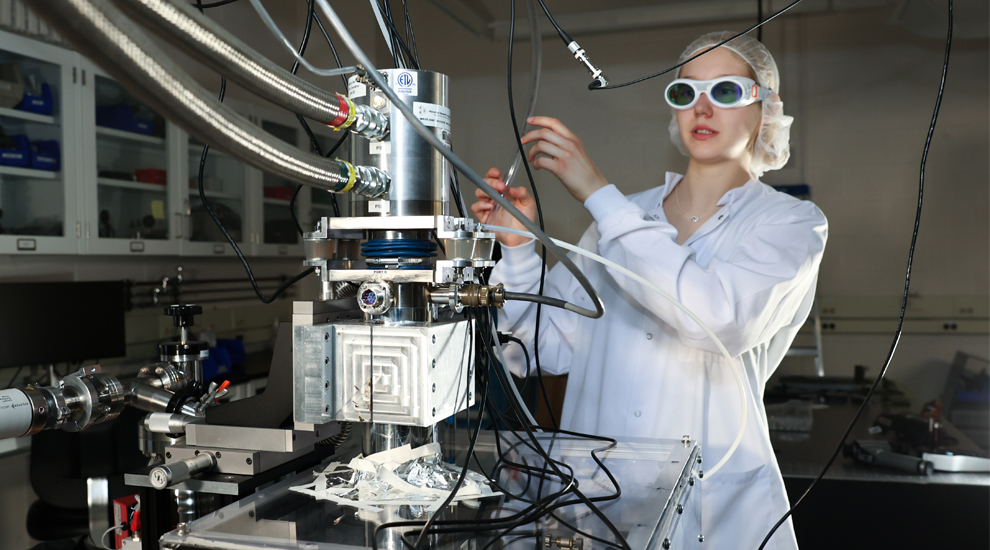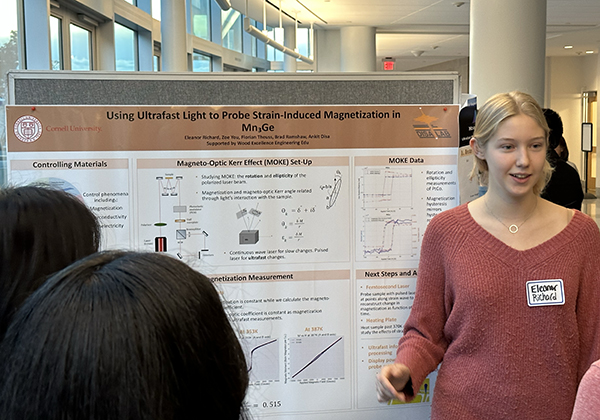Eleanor Richard '25: We are all capable of so much more than we believe.

by Diane Tessaglia-Hymes
Eleanor Richard ’25, from McLean, Virginia, has been named as one of 20 Optica Women Scholars for 2024.
Advised by Professor David Muller, and a member of Professor Ankit Disa’s lab, Richard was endorsed for this award by Disa, who noted that she is “extremely diligent, creative and resourceful.” Disa praised her motivation and commitment for pursuing research as well as her willingness to take on any challenge, and predicted that she is “poised to be a future leader in the field.”
As an Optica Women’s Scholar, Richard will receive a merit- and need-based grant, access to a mentorship platform and connection with a one of Optica’s mentors in their global network, and will be invited to attend the Optica Women Scholars Conference and the CLEO conference in May. “I am truly honored to receive this award,” said Richard. “Being selected to be part of the Optica Women Scholars encourages me to continue to build on my knowledge of optics and light-matter interactions and conduct research that will make a difference.”
Always an engineer
Richard knew from a young age that she wanted to study engineering, although when applying to colleges, she was not sure which field of engineering to pursue. When she found the engineering physics major in the School of Applied and Engineering (AEP) Physics at Cornell Engineering, she felt it was “perfect” because it could provide her with the necessary tools to pursue several different engineering disciplines. But what drew her in was the focus on nanoscience and quantum science within AEP, fields that she perceives to be “the future of science that have potential to positively impact the world.” She is primarily interested in studying “how to control materials with light for use in next-generation electronics, such as more powerful and efficient computers.”
After her freshman year, she read an article about a new professor, Ankit Disa, who was joining AEP that year. The description of his work and the focus of his lab intrigued her. “When I read about how Professor Disa had induced ferroelectricity in strontium titanate using an ultrafast laser pulse, I was fascinated,” Richard said. “The knowledge that one can manipulate properties such as ferroelectricity and magnetization in materials amazed me. With this science, the possibilities are endless. I contacted Professor Disa and was invited to join his lab.”

Disa describes Richard as a self-motivated, integral part of his group. “Our group specializes on the intersection of ultrafast optical processes and complex materials physics, an area that demands expertise in a variety of tools and concepts,” he said. “Eleanor was actually the very first person to join my group. As a sophomore, and despite the challenge of entering a new, complicated research field, she was completely undaunted. She taught herself the essential math, theories and experimental techniques needed, and within one semester had built a magneto-optical Kerr effect spectrometer – an instrument that measures magnetic properties of materials using light. Eleanor's initiative, enthusiasm and unwavering perseverance have left an indelible mark on our lab. From developing control software to designing new detection systems, her contributions over the past two years have been absolutely invaluable. Our lab owes much of its current and future success to Eleanor's outstanding efforts.”
Now in her fourth semester in Disa’s lab, Richard researches how to control the properties of materials using optical cavities. “In the ultrafast light experiments conducted in the field so far, properties such as ferroelectricity and magnetization have successfully been induced in some materials, but they have only lasted a few nanoseconds,” she explained. “To integrate this technique into electronic devices, the changes must last longer – if not permanently – so that the electronics can store data. We believe that we will be able to do this by using optical cavities. In theory, when certain materials are placed in this cavity, the light will induce permanent properties which we measure using ultrafast light pulses.”
During her three years at Cornell, Richard has been awarded four research grants from Engineering Learning Initiatives, providing funding for equipment to help her carry out her research projects. These awards are given to students who show outstanding potential for research, based on their academic or research record, faculty reviews and their written project proposal.

A natural leader, Richard is part of the AEP Diversity, Equity and Inclusion Committee. Last semester, she helped organize the first-ever AEP Student Showcase. More than 100 undergraduates, graduate students, postdoctoral associates, faculty and staff attended the event. They enjoyed comradery, learned about the student research projects underway in AEP, and celebrated student accomplishments.
Future goals
This summer, Richard plans to travel to Caltech and work in Professor David Hsieh’s lab, where she conducted research last summer. After graduating in 2025, she plans to continue her education and research in graduate school, expanding the body of knowledge about ultrafast dynamics and controlling matter with light.
“I hope to make impactful contributions in the field and make a positive difference in the world. More specifically, I hope to improve the way computers process and store information by furthering our ability to manipulate material properties with light,” she said.
Advice for students
AEP is one of the smaller schools in Cornell Engineering, but that can often be a benefit to students. To Richard, the small size means a close-knit community that provides opportunities for all students to get to know one another or work together on projects.
“Everyone in AEP is approachable and friendly, professors includes. I would say to anyone who is taking an AEP intro course or debating whether or not to take one: Don’t be afraid to talk to faculty. Reach out to the professor teaching the course for insight into the course and/or their research. Most often, they will be very happy to talk to you," she said.
“Also, I would suggest participating in a research project – and there are so many to choose from in AEP. Even if you aren’t sure if you want to go to grad school, participating in research can provide you with both interpersonal and technical skills that are generally applicable to other settings. For example, through participating in research projects, I have learned how to carefully evaluate and overcome challenges and how to effectively collaborate with others to reach a common goal. These are tools that I know I will use for the rest of my life.”
Richard continued, “And one final thought. Through my research and participation in the Cornell triathlon team – including two Olympic-distance triathlon competitions – I have learned that it’s important to persevere even when things get difficult. We are all capable of so much more than we believe.”

